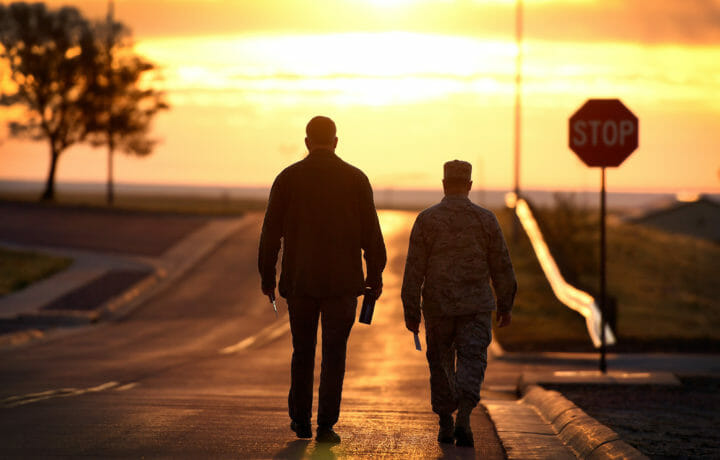Shortly after the fall of Baghdad in April 2003, I found myself standing on a busy street corner in Muhammadiyah with my brigade executive officer. During the march to the capitol city, we were cheered wildly by adoring crowds. As a gesture of goodwill, the brigade organized a humanitarian mission to provide fresh meat to the people of the city, and the brigade executive officer and I led the team that day.
Initially, things progressed as planned. Eager citizens waited patiently as troops distributed the meat from a commercial refrigeration truck, children visited with the Delta Company soldiers providing security, and everyone appeared genuinely happy. But something just didn’t seem right.
If hindsight is 20/20, foresight is myopic. The insurgency that would eventually sweep across the country was still at least a month away. The mood we’d experienced a week earlier in Muhammadiyah was vastly different than what would be the norm in Iraq’s Triangle of Death in the coming years. We were so focused on an image of cheering crowds along Highway 8 that we failed – at least initially – to notice the subtle changes in our environment.
Then I caught the look. I felt it more than anything, like a burning deep within my psyche. An Iraqi man in his mid-30s walked past us and glared at me menacingly. The adage, “if looks could kill,” barely described the intensity of the hatred in his eyes. Even as I nudged the executive officer, he was pointing out others, speaking quietly in a voice only I could hear. While our troops were busy passing out food, a number of military-age males had positioned themselves strategically around the crowd.
The message was clear: We weren’t welcome here.
Sensing that we needed to prevent an escalating situation from enveloping us, we ordered the detail to move away from the refrigeration truck and behind the perimeter of Delta Company security. Within moments, the men had whipped the crowd into a frenzy. AK-47s began to appear. A Molotov cocktail was thrown into the cab of the truck, then another. Gunfire could be heard in the distance. Even as flames engulfed the truck, we mounted our vehicles and made our way quickly out of the area.
During multiple tours in the Middle East, I felt the look more times than I can remember. Not always with the same hatred I sensed that day in Muhammadiyah, but unmistakably familiar. Sometimes it was disguised behind a smile, oftentimes not. There were those who welcomed me with genuine affection and others who looked on me with disdain, suspicion, distrust, and even anger. I was never more acutely aware of the color of my skin, the clothes I wore, or the distinctness of my features. This was their world, not mine. At best, I was an unwanted guest. At worst, I was a threat.
Fast forward 17 years. This morning, as I prepared to make my way to my home office and begin another day of work, I overheard a segment on an “honest talk about race” on the Today Show that caught my attention. One of the hosts, Craig Melvin, was describing what it feels like to be a “relatively young black man” raising children in America: “The number of times where you walk in a store and you know. You’re constantly reminded.”
The look. Many of us know what it feels like, but most do not. The stares. The glares. The shifting glances from the corner of the eye. People nervously moving away from you when you pass by. Others purposely avoiding eye contact. A level of discomfort that’s impossible to ignore.
The message is clear: You’re not welcome here.
As much as the look disturbed me that day in Muhammadiyah, I recognized that I was in hostile territory on foreign soil. To many, I was an invader, an interloper. It was their country and I understood as much – no matter how uncomfortable it made me feel. But in our country, on our soil, no one should be made to feel the way Craig Melvin described.
As veterans, many of us recognize the deeper meaning behind the look. We’ve experienced it; we can empathize with those forced to endure it. None of us would want to live our lives being subjected to it on a daily basis. Yet, many Americans suffer that fate so routinely it shapes their very existence, made to feel like a Stranger in Strange Land in their own country.
Most of us are familiar with the Native American aphorism, “Before you judge a man, walk a mile in his moccasins.” Some of us have walked in those moccasins, and it’s not a pleasant feeling – being judged by the color of your skin, the words you use, and the clothes you wear. No one would want to have to walk in those moccasins day in and day out: unwanted, unwelcome, and fearing for your own safety. Sadly, that’s the norm for many people, and they’re tired of it. Just as we were after a year (or more) of getting the look during what we knew was a temporary deployment.
As Kareem Abdul-Jabbar so aptly put it this weekend, this is not about “a rush to judgment, but a rush to justice.” If more people understood how it feels to wear those moccasins, how it feels to fear for your own life, then maybe America could start to heal. And finding justice – finding accountability – is the most important part of that healing process.




